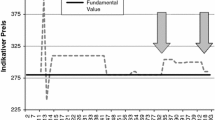Abstract
We deny that asymmetrical information is a market failure. In order to make this case, we subject to critical scrutiny the strongest case for this thesis: the view that laws prohibiting insider trading are viable, necessary, or compatible with the rule of law.
Similar content being viewed by others
Notes
Other than, whichever maximizes profits with a greater likelihood, from the businessman’s point of view.
This is a quote from Michael Dooley, quoted in Bainbridge’s introduction to the insider trading volume of Manne’s collective works. Dooley (1999).
It is very difficult to determine who knew what when.
They also exist under socialism. See Mises (1922).
References
Bagehot, W. (1971). The only game in town. Financial Analyst Journal, 27, 28–35.
Bainbridge, S. M. (2002). Corporation law and economics. New York, NY: Foundation.
Bainbridge, S. M. (2006). Introduction. In H. G. Manne (Ed.), The collected works of Henry G. Manne (Vol. 2). Los Angeles: Liberty Fund.
Bhattacharya, U., & Daouk, H. (2002). The world price of insider trading. Journal of Finance, 57, 75–108.
Block, W. E., & McGee, R. W. (1992). Insider trading. In R. W. McGee (Ed.), Business ethics and common sense (pp. 219–229). New York: New York Quorum Books.
Blue Chip Stamps v. Manor Drug Stores, 421 U.S. 723, 737 (1975).
Bris, A. (2005). Do insider trading laws work. European Financial Management, 11, 267–312.
Carlton, D. W., & Fischel, D. R. (1983). The regulation of insider trading. Stanford Law Review, 35, 857–895.
Coase, R. H. (1960). The problem of social cost. Journal of Law and Economics, 3, 1–44.
Cox, J. D. (1986). Insider trading and contracting: A critical response to the ‘Chicago School’. Duke Law Journal, 1986, 628–659.
Dolgopolov, S. (2004). Insider trading and the bid-ask spread: A critical evaluation of adverse selection in market making. Capital University Law Review, 33, 83–180.
Dooley, M. P. (1999). Comment from an enforcement perspective 50. Case Western Reserve Law Review, 319, 321–322.
Friedman, D., Harrison, G. W., & Salmon, J. W. (1984). The information efficiency of experimental asset markets. Journal of Political Economy, 92(3), 349–408.
Gilson, R., & Kraakman, R. (1984). The mechanisms of market efficiency. Virginia Law Review, 70, 549–644.
Haddock, D. D., & Macey, J. R. (1987). Regulation on demand: A private interest model, with an application to insider trading regulation. The Journal of Law and Economics, 30, 311–352.
Haft, R. J. (1982). The Effect of Insider Trading Rules on the Internal Efficiency of the Large Corporation. Michigan Law Review, 1051-1071.
Hebner, K. J., & Kato, T. (1997). Insider trading and executive compensation: Evidence from the U.S. and Japan. International Review of Economics and Finance, 80, 223–237.
Hu, J., & Noe, T. H. (1997). The Insider Trading Debate. Federal Reserve Bank of Atlana Economic Review, 82, 34–45.
Levitt, A. (1998, February 27). A Question of Integrity: Promoting Investor Confidence Figting Insider Trading. Retrieved November 4, 2013, from U.S. Securities and Exchange Commission: http://www.sec.gov/news/speech/speecharchive/1998/spch202.txt.
Lin, J.-C., & Rozeff, M. S. (1995). The speed of adjustment of prices to private information: Empirical tests. Journal of Financial Research, 18, 143–156.
Loss, L. (1970). The fiduciary concept as applied to trading by corporate ‘Insiders’ in the United States. Modern Law Review, 33, 34–52.
Manne, H. G. (1966). Insider trading and the stock market. New York: Free.
Manne, H. G. (2003). The Case for Insider Trading. Wall Street Journal-Eastern Edition, 241, A14.
Manne, H. G. (2006). Insider trading: Hayek, virtual markets, and the dog that did not bark. In H. G. Manne (Ed.), The collective works of Henry G. Manne (Vol. 2). Indianapolis: Liberty Fund.
McGee, R. W., & Block, W. E. (2004). An ethical and economic look at insider trading. In A. D. Wolf (Ed.), Ordered anarchy: Festschrift essays in honory of Anthony de Jasay. Arlington, VA: Singularity Press.
Meulbroek, L. K. (1992). An empirical analysis of insider trading. Journal of Finance, 47, 1661–1699.
Mises, L. V. (1922). Socialism: An economic and sociological analysis. Indianapolis: Liberty Fund.
Morgenson, G. (2012, May 19). Is insider trading part of the fabric on wall street. New York Times.
Pettit, R. R., & Venkatesh, P. C. (1995). Insider trading and long-run return performance. Financial Management, 24, 88–105.
Rothbard, M. N. (1982). The ethics of liberty. Atlantic Highlands, NJ: Humanitites Press.
Rothbard, M. N. (1990). Law, property rights, and air pollution. In W. E. Block (Ed.), Economics and the environment: A reconciliation (Vol. 2, pp. 233–279). Vancouver: The Fraser Institute.
Schotland, R. (1967). Unsafe at any price: A reply to Manne. Virginia Law Review, 53, 1425–1478.
SEC v. Texas Gulf Sulphur Co., 401. F2d 833, 84 8 (2d Cir 1968), cert. denied, 394 U.S. 976 (1969). (Second Circuit 1969).
Securities and Exchange Commission. (2000). Final rule: Selective disclosure and insider trading. Retrieved November 4, 2013, from U.S. Securities and Exchange Commission: http://www.sec.gov/rules/final/33-7881.htm.
Securities and Exchange Commission. (n.d.). Insider trading. Retrieved November 4, 2013, from U.S. Securities and Exchange Commission: http://www.sec.gov/answers/insider.htm.
Smith, A. (1776/2001). An inquiry into the nature and causes of the wealth of nations. Hayes Barton Press.
Thurber, S. (1994). The insider trading compensation contract as an inducement to monitoring by the institutional investor. George Mason University Law Review, 1, 313–316.
Wilgus, H. L. (1910). Purchase of shares of corpoation by a director from a shareholder. Michigan Law Review, 80, 1051–1071.
Author information
Authors and Affiliations
Corresponding author
Rights and permissions
About this article
Cite this article
Smith, T., Block, W.E. The Economics of Insider Trading: A Free Market Perspective. J Bus Ethics 139, 47–53 (2016). https://doi.org/10.1007/s10551-015-2621-5
Received:
Accepted:
Published:
Issue Date:
DOI: https://doi.org/10.1007/s10551-015-2621-5



